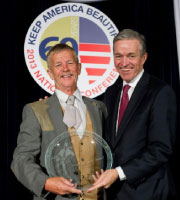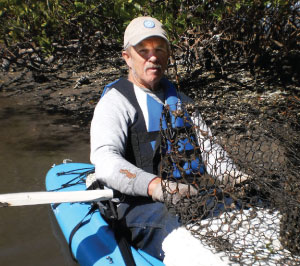 |
||||||||

Profile:
Meet Jim Igler: Super Volunteer
If you’ve ever volunteered to help improve Tampa Bay’s ecosystems, you’ve probably met Jim Igler.

Igler, left, accepts Keep America Beautiful's most prestigious award from the organization's president, Matthew M. McKenna.
He’s the guy who has a near-perfect attendance record at the Tampa Bay Estuary Program’s Give a Day for the Bay events. Or you may have seen him pulling abandoned crab traps with Tampa Bay Watch, or cleaning up underwater trash with Keep Tampa Bay Beautiful. He leads Green Team at the Florida Aquarium and is the volunteer dive team leader, working to restore local coral reefs and maintain the aquarium’s shark tanks. Other days, he’s helping to build “love boats” where least terns can lay their eggs at Fort DeSoto, repairing historic structures on Egmont Key or pushing efforts to make the Gasparilla parade more eco-friendly.
He’s also the guy who won the most prestigious award given by one of the nation’s most respected organizations, Keep America Beautiful’ s Iron Eyes Cody Award, named for the 1970s “Crying Indian” advertising campaign that helped kick off the country’s fledgling environmental movement.
“Jim Igler’s passion for the environment shines a bright light on many coastal Florida communities,” said Matt McKenna, president of Keep America Beautiful. “He’s a true hero, an inspiration to the Tampa Bay community as well as to all of us.”
It didn’t start out that way.
Raised on a Pennsylvania dairy farm, Igler earned a degree in vocational agriculture from Oklahoma State University before he realized that driving a truck paid more money than teaching — and let him see more of the country. When he retired, he bought a small home on a canal near Cockroach Bay, then went right back to work.
He had learned to scuba dive on a Caribbean vacation, and the Florida Aquarium was looking for volunteers, so he signed up to help. As he met more people from other organizations, he joined Tampa Bay Watch, the Tampa Bay Estuary Program, then Keep Tampa Bay Beautiful and the Egmont Key Alliance and St. Petersburg Audubon Society.
“I could see the jobs that needed to get done, and I knew I could help,” Igler says. “I didn’t do it for the awards — I did it because I enjoy it. I get to work with people I might not meet otherwise and make a difference in the world.”

Jim Igler participates in dozens of clean-up events in Tampa Bay every year, including a recent derelict crab trap removal event sponsored by Tampa Bay Watch.
Igler lives his commitment to improving the environment every day. Rather than a seawall on his canal, he put down rip-rap so mangroves can grow along the water’s edge, creating habitat for juvenile fish, crabs and birds. When his central air conditioner conked out two years ago, he opened his windows and learned to live without it. His next home project is setting up a chicken coop — made from recycled materials he’s collecting now — so he can harvest his own eggs.
In fact, the best part of winning an important national award is the credibility it gives him as he continues his campaign to make Tampa Bay a better place. “It will be a great platform,” he says. “People are much more likely to listen to me now.”
For instance, he’d like to see the final float at the Gasparilla parade set up to collect and recycle beads and bottles – instead of diving off Bayshore to clean up the petroleum-based plastic trash. And new regulations that require every new home in Florida to be outfitted with solar panels and systems that harvest rainwater. Or giant coolers at clean-up events instead of thousands of bottles of water, maybe even seeing event leaders pass out reusable cups instead of t-shirts for participants.
“There’s always something we can do better,” he says. “And if everybody did just a little bit to help the environment, we’d all be so much better off.”
When he first arrived in Tampa Bay in the late 1980s, the water in the bay was brown, but he was used to it. “I’d been living in Oklahoma and Kansas and water is usually brown there.” As he learned more about the challenges facing the bay, he got more involved in restoring it.
“It’s a shame that more people don’t realize that Tampa Bay is one of the only urban estuaries in the world where water quality has actually improved over the last few decades instead of declining.”
